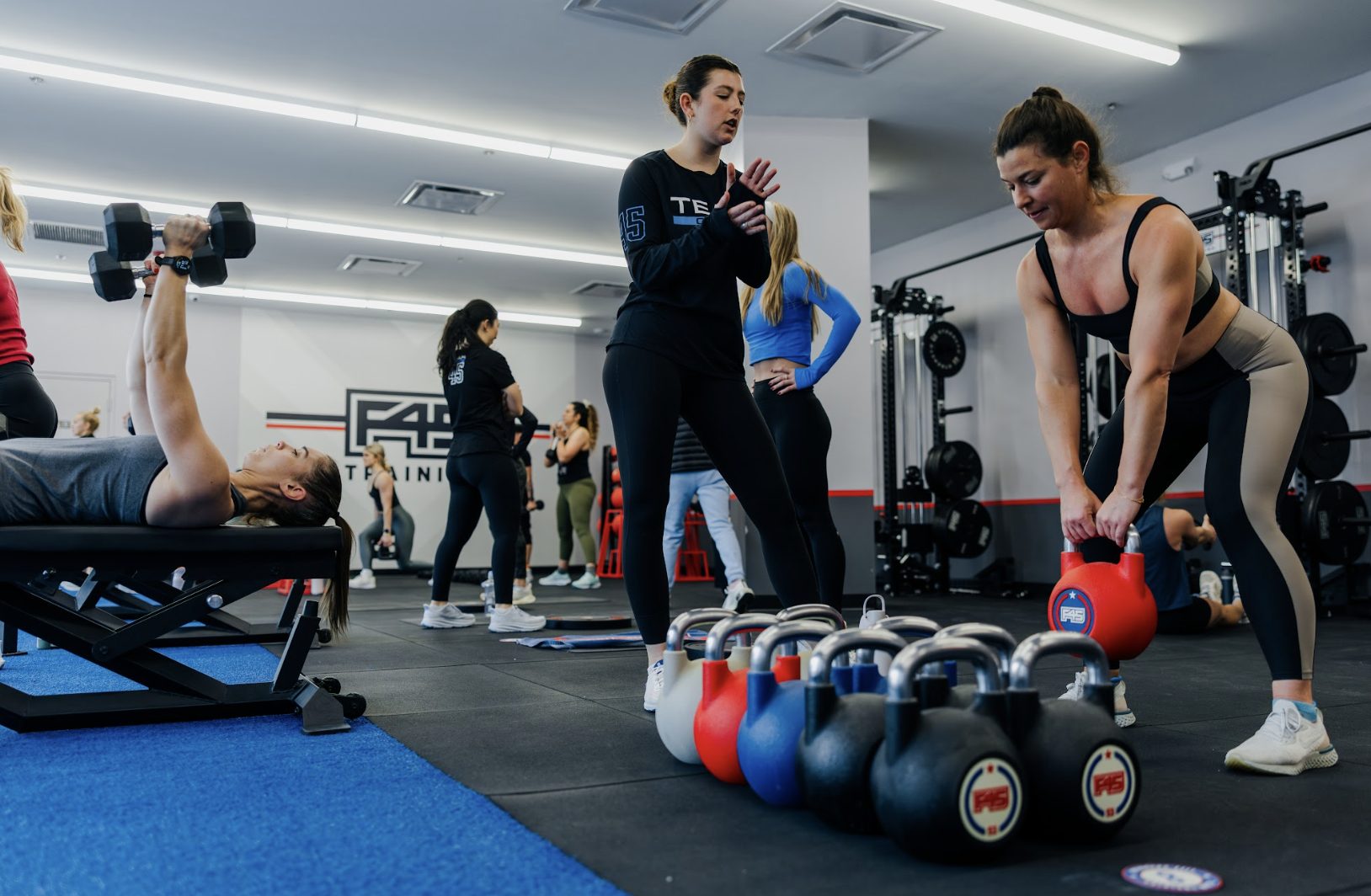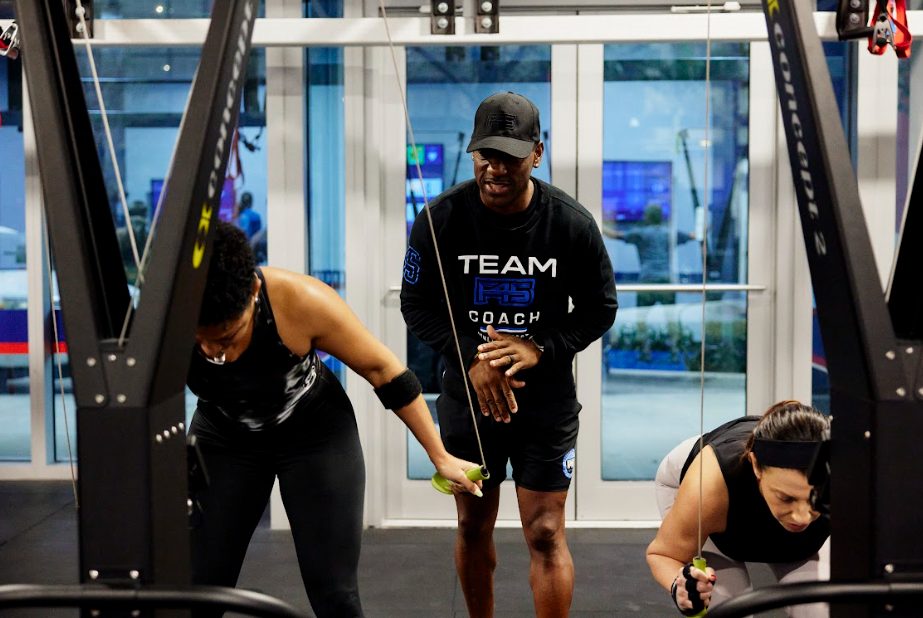Isometric exercises are powerful and effective movements that offer a range of benefits for a workout routine. Whether you want to perform a few isometric movements to build and maintain muscle, or you’re in a situation – such as recovering from an injury – where a full isometric workout can promote your healing, read on to learn what isometrics are, browse their benefits, and explore a range of exercises that will enhance your isometric fitness.
What are isometrics?
Isometric exercises are a form of strength training, where you engage your muscles in a held position for an extended period, maintaining muscle tension. Exemplified by the many exercises you can find during an F45 Training workout.
Holding a position is useful for improving your strength, stability and endurance – and, because you’re not moving, the exercise is kept low-impact. Less movement can be especially useful for preventing injury during exercise, or for muscle strengthening while recovering from one.
That said, isometric exercises shouldn’t necessarily replace more dynamic exercises that work the same muscles. That’s why F45 workouts are designed with a variety of movement types to help you hit your unique fitness goals.

The benefits of isometric training
Isometric training is a unique and effective resistance workout that develops your functional strength. Better still, because isometric exercises focus on holding certain positions, they require little to no equipment.
Read on to learn about the benefits of isometric workouts.
Increases muscle endurance
Isometric exercises improve your muscle endurance, as they require sustained tension in your muscles. Over time, you’ll be able to hold positions for longer, or with increased resistance. This can be useful for reducing back strain during a workout or maintaining the right posture in everyday movements: such as sitting, standing, or lifting furniture.
Improves muscle stability
By engaging muscles without movement, isometric workouts strengthen the stabilizers that support your joints. Better stability helps you feel more comfortable with everyday movement and can give you confidence when trying new exercise techniques – especially those that include using weights.
Provides pain relief
Isometrics can reduce tendon pain1 and joint pain². By holding your muscles in a contracted position, isometric exercises can help alleviate muscle stiffness and tension that’s causing pain. Strengthening your muscles can also address aches or pains you have from poor posture or imbalances in the body.
Builds strength
Even though isometric workouts are not dynamic, they’re still useful for increasing your muscle power and size3. As mentioned earlier, though, the strength you’re building will be specific to holding movements.
Supports rehabilitation
For recovery from injury, isometric exercises can help you redevelop your strength and confidence while minimizing the risk of re-injury. They’re effective because they enable you to find a position where your pain-free – and hold it.
For example, if you need to modify exercises for knee pain, you can use isometric fitness to strengthen your quads and hamstrings, which helps to reduce joint pain and increase your range of motion over time.
7 isometric exercise examples
Isometric exercises are fantastic for strength, endurance and your overall stability. To enjoy the many benefits of isometric training, however, you’ll first need to know which isometric exercises to do.
Below, we’ll guide you through our top 7 isometric exercises, providing clear instructions on how to perform them.
1. Planks
Effective for elevating your core, shoulder and back strength, planks are a classic isometric exercise.
To perform a plank:
- Start in a push-up position, with your forearms on the ground.
- Keep your body in a straight line from your head to your heels.
- Hold for as long as you can without letting your hips dip or back arch.
2. Wall sit
Wall sits are ideal for targeting the powerhouse muscles in your legs: including your quads, hamstrings, and glutes.
To perform a wall sit:
- Stand with your back against a wall and slide down until your knees are bent at a 90-degree angle.
- Make sure your thighs are parallel with the ground.
- Engage your core and hold the position for as long as you can.
3. Glute bridge hold
A staple of all good leg-centric isometric workouts, glute bridge holds can enhance your glute, hamstring, and lower back power.
To perform a glute bridge hold:
- Lie on your back.
- Bend your knees, making sure your knees are flat on the floor and hip-width apart.
- Push your hips up into the air, so that your body forms a straight line with your shoulders and knees.
- Hold the position for 40 seconds, then rest for 20 seconds, repeating the process three times.
4. Squat hold
Any great workout includes squat holds, mainly because they elevate your hips and knee flexibility.
To perform a squat hold:
- Stand up with your feet shoulder-width apart.
- Lower your body into a squat position, keeping your knees behind your toes.
- Make sure your thighs are parallel with the ground; that your chest is up, and that your back is straight.
- Hold the position for as long as you can while maintaining proper form.
5. Calf raise hold
Isometric calf raises are a simple exercise, yet play an important role in your lower-leg, ankle, and foot stability.
To perform a calf raise hold:
- Stand with your feet hip-width apart.
- Slowly raise your heels off the ground, so you’re on the balls of your feet.
- Hold this position for as long as you can stay balanced.
6. Superman hold
The superman hold is one of many recommended exercises for shoulder pain, as it activates the muscles around the top of your shoulders and improves spinal stability.
To perform a superman hold:
- Lie face down on the floor.
- Extend your arms out in front of you, and your legs behind you.
- Hold this position for 30 seconds, then rest for 10 seconds.
- Repeat this process three times.
7. Dead hangs
Awesome for upper body isometric fitness, dead hangs enhance your grip, shoulder and forearms. They’re also useful for improving spine flexibility.
To perform a dead hang:
- Find a pull-up bar and stand underneath it.
- Using an overhand grip (palms facing away) grab the pull up bar.
- Keep your hands shoulder-width apart and let your body hang freely.
- Engage your core to prevent swinging.
- Hold the position for as long as you can while feeling in control.
Isometric workout tips
The benefits of isometric exercises are empowering, but the key to your results will lie in the details. Keep reading for some simple tips to refine your isometric workouts and help you get the most of your efforts.
Focus on form
Maintaining proper form will help you reap the benefits of strength training. Often you will start an exercise in the correct posture, but as you begin to feel the burn, you might unknowingly adjust your posture – putting unhealthy strain on your body. To combat this, F45 trainers are always there to support you, and provide technique adjustment to keep your body safe. If you’re working out at home, we recommend doing isometric workouts in front of a mirror, so you can self-adjust if required.
Practice controlled breathing
Breathing plays a key role in all isometric exercises. It keeps you calm, maintains your focus, and helps your muscles engage as you hold your position.
Throughout any isometric exercise, inhale deeply through your nose and exhale slowly through your mouth. Locking in a steady rhythm will prevent you from holding your breath and losing your form – especially when your muscles begin to burn!
Use your mind-muscle connection
Consciously engaging the muscles you’re using will help you gain better workout results4. After all, isometric workouts are just as much about mental focus as they are about strength and endurance. For different exercises, visualize and think about the main muscle groups you’re working to support muscle activation – this could be tensing your core while planking, or mindfully engaging your lower back while performing superman holds.
By building your isometric fitness, you can make everyday tasks more comfortable, reduce your risk of injury, and ready your body for more dynamic forms of exercise. Speaking of dynamic exercise, learn about the difference between HIIT training and traditional cardio next.
Sources:
1 https://pubmed.ncbi.nlm.nih.gov/25979840/
2 https://pmc.ncbi.nlm.nih.gov/articles/PMC8604435/
3 https://pubmed.ncbi.nlm.nih.gov/30580468/
4 https://pubmed.ncbi.nlm.nih.gov/26700744/













